Thanks to the powerful roots of the grapes, drought is not terrible. However, do not forget about watering, especially in the summer heat. Abundant moistening of the earth at suitable times promotes the active growth of bushes and fruit loading, increases frost resistance and immunity. In order for bushes to please a good harvest, you need to know the methods and features of watering. Proper soil moisture improves plant nutrition. When and how to water grapes in different climatic zones?
Content
- 1 The value of water for plants
- 2 When to water grape bushes
- 3 How to water seedlings
- 4 The value of vegetative irrigation
- 5 Watering Methods
- 6 Features of watering
- 7 Watering and feeding
- 8 How often to water the grapes
- 9 How much water do grapes need
- 10 Consequences of deficiency and excess moisture
- 11 Reviews
The value of water for plants
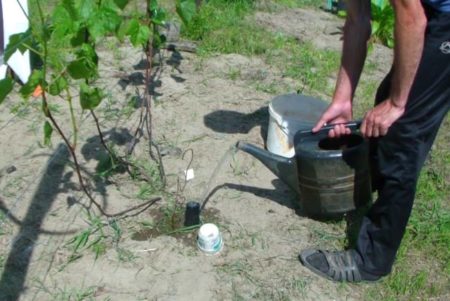 Water is an important component that is involved in all intracellular processes of plants. All nutrients enter the tissues in dissolved form. Micro and macro elements are not absorbed by roots from dry soil. Water is involved in the movement of nutrients, as well as evaporation, removing excess heat from the leaves. The intensity of such a mechanism depends on humidity. In dry weather, water from plant tissues evaporates faster. With a lack of moisture, the internal temperature rises above optimal values. As a result, grapes receive “heat stress”.
Water is an important component that is involved in all intracellular processes of plants. All nutrients enter the tissues in dissolved form. Micro and macro elements are not absorbed by roots from dry soil. Water is involved in the movement of nutrients, as well as evaporation, removing excess heat from the leaves. The intensity of such a mechanism depends on humidity. In dry weather, water from plant tissues evaporates faster. With a lack of moisture, the internal temperature rises above optimal values. As a result, grapes receive “heat stress”.
When to water grape bushes
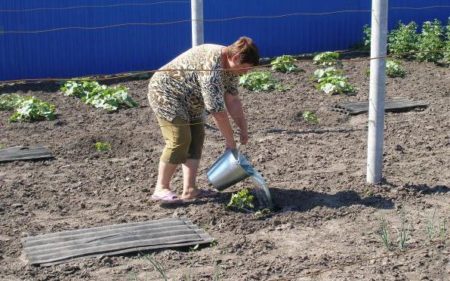 Watering grapes is important at all stages of its development. The frequency and frequency of soil moisture depends on various factors: the growing region, the number of rainy days, soil composition, plant variety and age, the level of groundwater, and the irrigation method. In areas where torrential rains are frequent, grape bushes are not watered at all. In the south and in the middle zone of Russia, plants need to provide timely moistening of the near-stem soil.
Watering grapes is important at all stages of its development. The frequency and frequency of soil moisture depends on various factors: the growing region, the number of rainy days, soil composition, plant variety and age, the level of groundwater, and the irrigation method. In areas where torrential rains are frequent, grape bushes are not watered at all. In the south and in the middle zone of Russia, plants need to provide timely moistening of the near-stem soil.
Watering grapes in spring
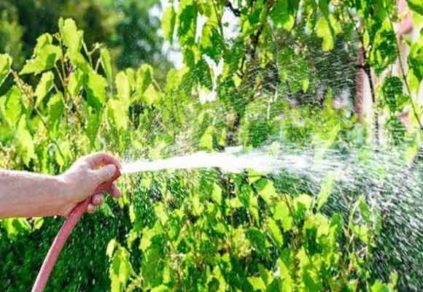 At the beginning of the growing season, roots, shoots and foliage quickly grow. After opening, the buds have not yet swollen, grape bushes must be well watered. After a snowy winter, the earth should be charged with moisture. In dry spring weather, grapes must be watered in April. The awakening time of plants depends on the temperature of the irrigation water: a warm liquid accelerates the dissolution of the kidneys, and a cold one inhibits. This feature must be considered if return frosts are anticipated.
At the beginning of the growing season, roots, shoots and foliage quickly grow. After opening, the buds have not yet swollen, grape bushes must be well watered. After a snowy winter, the earth should be charged with moisture. In dry spring weather, grapes must be watered in April. The awakening time of plants depends on the temperature of the irrigation water: a warm liquid accelerates the dissolution of the kidneys, and a cold one inhibits. This feature must be considered if return frosts are anticipated.
Most of all, grape bushes need moisture during the appearance of young leaves, the active growth of the vine. Plants should be watered approximately 20 days before the appearance of flowers. On average, the soil is moistened 3 times in spring. Flowering grapes are not recommended to be watered. Otherwise, part of the inflorescences will fall and there will be less clusters.
Watering grapes in summer
Lack of precipitation and heat are frequent occurrences associated with summer weather. When the berries begin to pour, the need for hydration increases. Grapes should receive 1/2 seasonal water. With the advent of summer, it is watered when pea-sized berries are formed, and the next time in the last days of July.
It is believed that moistening the soil around grapes in August only harms the future crop. The earth continues to be moistened until the fruit softens, the appearance of a characteristic varietal color of the skin.Watering the grapes in the summer during the ripening of the berries often leads to cracking of the skin, the development of gray rot. Later varieties are watered in August as well. their berries ripen in September or October.
Autumn watering
Is it possible to water grapes in autumn? In order to prepare plants for the coming frosts, in autumn it is necessary to moisten the trunk section well. In winter, dry soil cracks and the roots freeze. If it rains often in the fall, the vineyard is not watered. In the southern regions, where the bushes are not covered for the winter, the earth is well moistened after the leaves fall. In areas with a cold climate, grapes are watered after shelter. The approximate time is the end of October or the first days of November. Late-ripening varieties, the fruits of which are intended for long-term storage, stop watering a month before harvesting.
How to water seedlings
So that after planting the seedlings are well rooted, the soil must always remain moist. The liquid is poured into a circular hole, which is dug at a distance of 30 cm from the stem. Its depth should be 25 cm and a width of 60 cm. Watering grape cuttings after planting is carried out at least 1 time in 7-10 days, avoiding waterlogging. When the water in the hole is absorbed, it is sprinkled with dry soil. With circular irrigation, the earth is moistened uniformly, and the roots grow evenly.
For each seedling spend 10-15 liters of water, which is poured within the boundaries of the pit. If the bushes do not grow well, they use drugs to stimulate root formation: Heteroauxin, Ribav-extra, or Kornevin. In mid-summer, rooted cuttings need to be watered about 2-3 times in 30 days. The frequency of the procedure depends on the size of the young bush and climate. In the heat, the rate of water is increased. So that before the arrival of winter the vine has time to ripen, young plants are last watered abundantly in August.
The value of vegetative irrigation
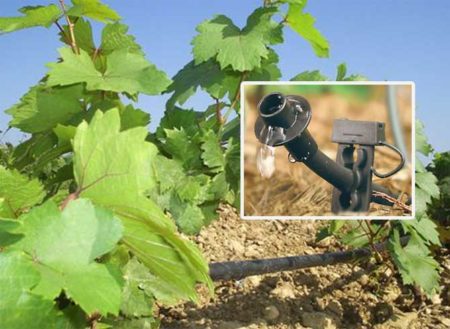 In summer drought, vegetative irrigation is carried out. Their main task is to retain moisture in the soil, contributing to the normal development of the bush and its cooling. To understand the advantages of summer watering, one should know at what stages the process of fruit formation is.
In summer drought, vegetative irrigation is carried out. Their main task is to retain moisture in the soil, contributing to the normal development of the bush and its cooling. To understand the advantages of summer watering, one should know at what stages the process of fruit formation is.
The grape buds bloom at a temperature of + 12 ° С. When the thermometer reaches + 25 ° C, shoots begin to grow rapidly, and a little later flowers appear on the vine. The optimum temperature for ripening the crop is + 30 ° C. Summer watering under the root improves the absorption of nutrients. Without enough moisture, the berries will be much smaller. When the temperature starts to drop to + 15 ° C, the bunches of grapes will already look ripe. The formation of sugar in the berries stops.
In areas where summer temperatures can reach + 40 ° C, you need to take care of the regular flow of water to the grape bushes. In areas with a temperate climate, grapes do not need frequent and plentiful moistening of the earth. Plants should be watered as needed when the soil dries. If the drought is not severe, grapes can easily cope with the distribution of liquid. Stem nutrition also includes the consumption of leaves. Therefore, in order for the fruits to grow large and sweet, you do not need to save water, because in hot weather excess moisture evaporates quickly.
Watering Methods
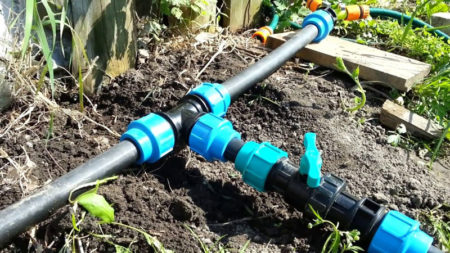 Gardeners use 2 methods of watering grapes: surface and underground. When moistening the soil in the first way, water is poured into grooves with a depth of 20 cm made between the rows. They are placed at a distance of 60 cm from the bush. The surface method is ineffective for adult bushes, because their roots reach a depth of more than 0.5 m. This technology is acceptable for seedlings.
Gardeners use 2 methods of watering grapes: surface and underground. When moistening the soil in the first way, water is poured into grooves with a depth of 20 cm made between the rows. They are placed at a distance of 60 cm from the bush. The surface method is ineffective for adult bushes, because their roots reach a depth of more than 0.5 m. This technology is acceptable for seedlings.
The most successful option for surface irrigation include drip irrigation. With this method, the effect of gradual moistening of the soil is achieved. Between the bushes at a distance of 25 cm lay out a special tape.Through it, the necessary volume of water enters the grapes, improving fruiting.
The underground watering method has its advantages:
- It takes much less water to deeply moisten the soil, because she goes directly to the roots.
- Increases frost resistance of grapes. Plants actively grow deep roots, which are less likely to be damaged by winter frosts, in contrast to superficial roots.
- Deep layers of soil are saturated with water, and the surface around the plant remains dry, which reduces the risk of developing a fungal infection.
Features of watering
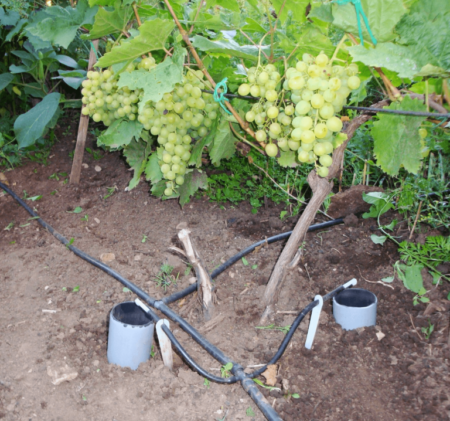 Grapes are a culture that easily adapts to the heat. In summer, in the middle lane for filling grapes, the usual rainfall rate is sufficient. But when cultivating cultivars, additional moisture is indispensable. Proper watering helps to achieve maximum productivity of bushes and to reveal varietal qualities.
Grapes are a culture that easily adapts to the heat. In summer, in the middle lane for filling grapes, the usual rainfall rate is sufficient. But when cultivating cultivars, additional moisture is indispensable. Proper watering helps to achieve maximum productivity of bushes and to reveal varietal qualities.
When caring for grapes, you need to consider such features of watering:
- It is better to under-fill the water than to water the soil. Excess moisture stimulates the growth of superficial roots, which freeze during severe frosts.
- With a long interval between irrigation, the soil dries up. Berries may crack due to lack of moisture.
- Enhanced stalk growth is an occasion to reduce the volume of fluid. And if the bushes grow slowly, you need to water and feed them with nitrogen fertilizers.
- With a prolonged absence of precipitation, grapes need a generous moistening of the soil. When the fruits begin to soften and acquire a characteristic color, the bushes are watered more often, increasing the rate of water.
- If the soil heated by the scorching summer sun is poured with cold water, the plants will experience heat shock. The reason for this effect is the temperature difference. Therefore, it is permissible to water from a well only in the predawn or evening time. The second type of error is spraying bushes with warm water under high pressure.
- To moisten the soil, you can use rainwater. It is collected in barrels of 200 liters.
- Moistened soil should be loosened to improve breathability. This measure prevents root decay and the rapid evaporation of moisture. The earth is loosened when the water is absorbed, and the soil dries out a little.
Watering and feeding
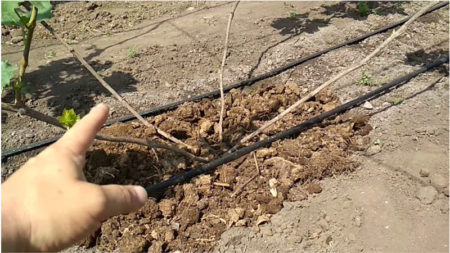 To grape seedlings previously entered into fruiting and gave a good harvest, you need to properly combine watering and top dressing. In spring, the bush is fertilized with mineral mixtures enriched in phosphorus, nitrogen and zinc. To get the best effect, they are combined with organics: chicken droppings, compost, rotted manure.
To grape seedlings previously entered into fruiting and gave a good harvest, you need to properly combine watering and top dressing. In spring, the bush is fertilized with mineral mixtures enriched in phosphorus, nitrogen and zinc. To get the best effect, they are combined with organics: chicken droppings, compost, rotted manure.
In the summer after watering, fertilizer is added that does not contain nitrogen. The last time grapes are fed 14 days before the harvest of ripened bunches. Timely soil moisture and regular feeding increase the resistance of grapes to various diseases. And the berries are juicy and sweet.
How often to water the grapes
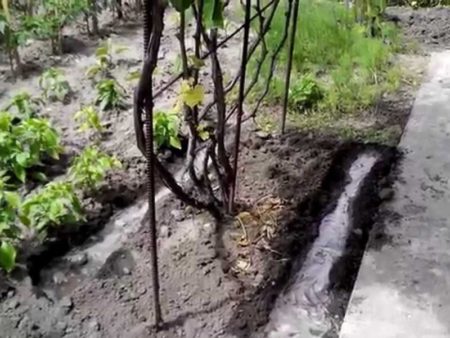 Different factors affect the timing of irrigation and the volume of liquid: climatic features, soil composition, weather conditions, variety, method of soil moisture, plant age and number of ovaries. In arid climatic zones, bushes are watered more often. If grapes are grown on sandy soils, the interval between humidifications is shorter, and portions of water are smaller. Grapes growing on clay soils or chernozem require rare but plentiful watering. Adult plants and late varieties in the summer need more frequent hydration, when compared with young plantings.
Different factors affect the timing of irrigation and the volume of liquid: climatic features, soil composition, weather conditions, variety, method of soil moisture, plant age and number of ovaries. In arid climatic zones, bushes are watered more often. If grapes are grown on sandy soils, the interval between humidifications is shorter, and portions of water are smaller. Grapes growing on clay soils or chernozem require rare but plentiful watering. Adult plants and late varieties in the summer need more frequent hydration, when compared with young plantings.
Watering grapes produced in the growing season:
- after fixing the plants to the support;
- after spring pruning, if the weather turned out to be dry;
- when young shoots reach a length of 35 cm;
- during the appearance of buds;
- in summer, when pea-sized berries form;
- to soften the fruit;
- in the fall, in preparation for the winter.
Using the underground method, the soil is moistened at least 1 time in 14-20 days, if there is no heavy rainfall. With the surface method, you need to take into account weather conditions and observe the condition of the plants. Moisture deficiency can be recognized by the weak growth of shoots, friability of clusters, small berries. Excessive watering causes waterlogging, which is manifested by the following symptoms:
- enhanced growth of stems and stepsons;
- delay in the formation of berries;
- water content and low sugar content of pulp;
- uncharacteristic color in dark varieties;
- weak ripening of the vine.
How much water do grapes need
Each plant must be provided with such an amount of liquid that the soil is moistened to a depth of 0.5-1 m. The water norm is 60-90 l per 1 m2. Sandy soil will require 1.5 times more fluid. Half of the norm is poured under grapes under the age of 3 years, and 2/3 of the required volume of water is poured under the bush up to 8 years of life. After a snowy winter, about 250 liters are taken per spring for moistening. In long dry weather use the same amount of water. The need for moisture increases during the ripening of berries. For each vegetation irrigation spend 50-70 liters of water per 1 m2.
Consequences of deficiency and excess moisture
With poor moisture, grapes grow a lot of surface roots to the detriment of the main. From irregular soil moisture, the roots periodically dry up and grow back. You should not expect a good harvest from grapes that are constantly under stress. Overdried land cracks in the summer heat, the roots are torn, and the plants dry out.
Excess moisture causes the following effects:
- nutrients are washed out;
- fungal diseases occur;
- rotting the roots;
- berries crack, become acidic;
- ripe fruits do not tolerate transportation and storage.
With untimely watering, the berries take the form of shriveled balls, stop in development. They are lethargic and tasteless. With a moisture deficit, the vine loses part of the leaves, and the remaining ones become dry. In drought, in the absence of watering, vine and root sprawl is observed, which affects other garden plants.
Reviews
Gardeners and summer residents who properly organized the irrigation of grapes are pleased with the results. They note a good growth of shoots, an abundance of clusters, an improvement in the quality of the fruit. If water grapes in summer regularly, he tolerates heat more easily. With deep moistening, a significant increase in yield is observed. Experienced winegrowers choose the underground method for watering plantings, as consider it the most effective.
Proper watering is important grape care condition. It is important to adhere to the norms and optimal timing of irrigation. When choosing a humidification method, climatic conditions, soil composition and planting area should be taken into account.In drought, watering grapes should be carried out regularly. With timely moistening of the earth, especially in summer, plants will please with an abundance of delicious berries.




 Non-covering winter-hardy grape varieties for Moscow region
Non-covering winter-hardy grape varieties for Moscow region How to keep the vine in winter
How to keep the vine in winter When can I transfer grapes to another place in the fall
When can I transfer grapes to another place in the fall How to cover and prepare grapes for the winter in the suburbs
How to cover and prepare grapes for the winter in the suburbs